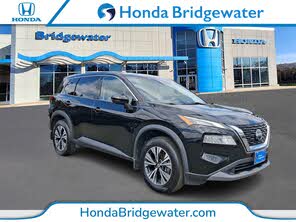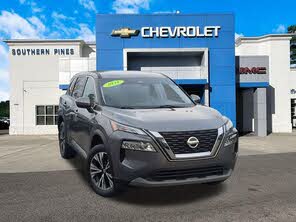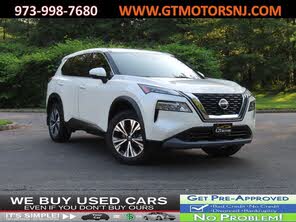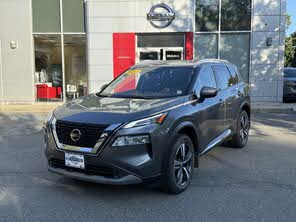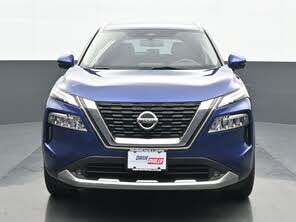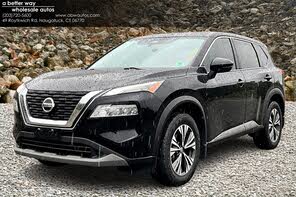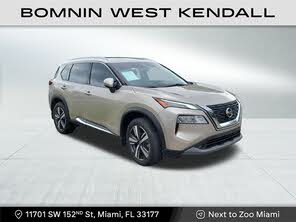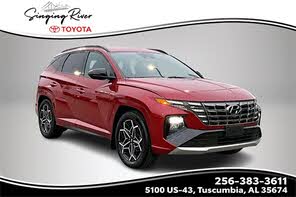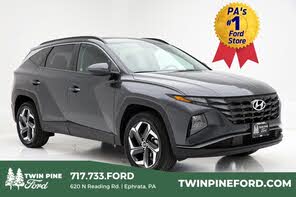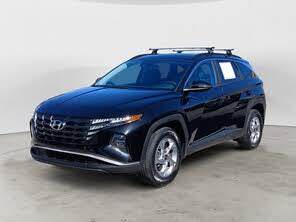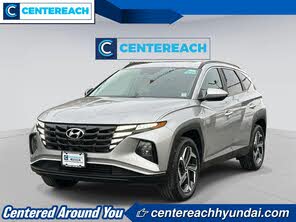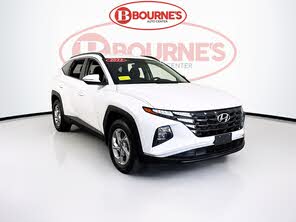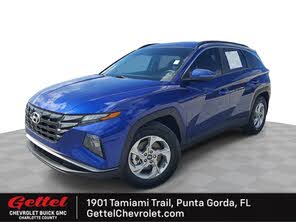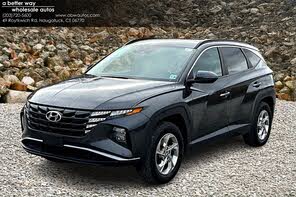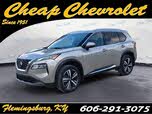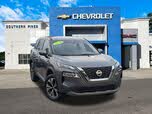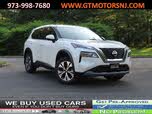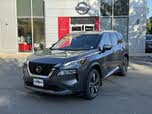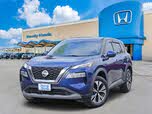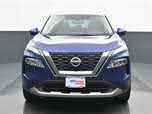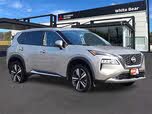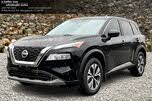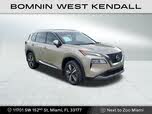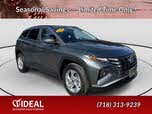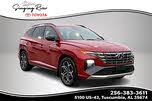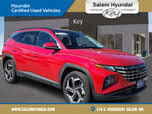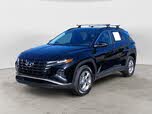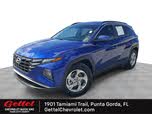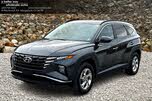2021 Nissan Rogue vs 2022 Hyundai Tucson
Overview | |
MSRP$26,050 | MSRP$25,800 |
Listings2468 | Listings1956 |
Ratings & Reviews | |
User Reviews | User Reviews |
Expert reviews9.0 out of 10 | Expert reviews8.3 out of 10 |
Pros
Cons
| Pros
Cons
|
2021 Nissan Rogue Reviews SummaryTo characterize the all-new 2021 Nissan Rogue as vital to the automaker's success is an understatement. Not only is the compact crossover SUV the best-selling Nissan in America, but it's also one of the best-selling vehicles in America. Strip out pickup trucks, and the Rogue sits near the top of the U.S. sales chart with its primary competitors, the Honda CR-V and Toyota RAV4. Imagine the pressure on Nissan designers, engineers, and product planners as they prepared the current Rogue's replacement! The good news is that the new Rogue is a better SUV in every way but one. | |
2022 Hyundai Tucson Reviews SummaryThe redesigned 2022 Hyundai Tucson has to offer a high-tech cabin, comfortable ride, competent engine lineup, and spacious cargo area to keep up with the Joneses in the hot-selling and competitive compact SUV class. It does that, and more, with Hyundai giving plenty of compelling reasons to take the 2022 Tucson for a test drive. | |
Popular Features & Specs | |
Engine2.5L 181 hp I4 | Engine2.5L 187 hp I4 |
Drive TrainFWD | Drive TrainFWD |
Seating Capacity5 | Seating Capacity5 |
Horsepower181 hp @ 6000 rpm | Horsepower187 hp @ 6100 rpm |
MPG City27 | MPG City26 |
MPG Highway35 | MPG Highway33 |
Engine | |
Engine Name2.5L 181 hp I4 | Engine Name2.5L 187 hp I4 |
Torque181 lb-ft @ 3600 rpm | Torque178 lb-ft @ 4000 rpm |
Horsepower181 hp @ 6000 rpm | Horsepower187 hp @ 6100 rpm |
DrivetrainFWD | DrivetrainFWD |
Fuel Economy | |
MPG City27 | MPG City26 |
MPG Highway35 | MPG Highway33 |
Interior | |
Seating Capacity5 | Seating Capacity5 |
Safety | |
Front Crash Overall3 | Front Crash Overall4 |
Side Crash Overall5 | Side Crash Overall5 |
Dimensions & Capacity | |
Cargo Space31.6 cu ft | Cargo Space38.7 cu ft |
Curb Weight3371 lbs | Curb Weight3329 lbs |
Height66.5 in | Height65.6 in |
Length183.0 in | Length182.3 in |
Width72.4 in | Width73.4 in |
Wheelbase106.5 in | Wheelbase108.5 in |
Maximum Payload1115 lbs | Maximum Payload1301 lbs |
Number of doors4 | Number of doors4 |
Maximum Towing Capacity | Maximum Towing Capacity2000 lbs |
Standard Towing Capacity | Standard Towing Capacity2000 lbs |
Overview | ||
MSRP | $26,050 | $25,800 |
Listings | ||
Ratings & Reviews | ||
User reviews | ||
Expert reviews | 9.0 out of 10Read full review | 8.3 out of 10Read full review |
Pros & cons | Pros
Cons
| Pros
Cons
|
Summary | To characterize the all-new 2021 Nissan Rogue as vital to the automaker's success is an understatement. Not only is the compact crossover SUV the best-selling Nissan in America, but it's also one of the best-selling vehicles in America. Strip out pickup trucks, and the Rogue sits near the top of the U.S. sales chart with its primary competitors, the Honda CR-V and Toyota RAV4. Imagine the pressure on Nissan designers, engineers, and product planners as they prepared the current Rogue's replacement! The good news is that the new Rogue is a better SUV in every way but one. | The redesigned 2022 Hyundai Tucson has to offer a high-tech cabin, comfortable ride, competent engine lineup, and spacious cargo area to keep up with the Joneses in the hot-selling and competitive compact SUV class. It does that, and more, with Hyundai giving plenty of compelling reasons to take the 2022 Tucson for a test drive. |
Video | ||
Popular Features & Specs | ||
Engine | 2.5L 181 hp I4 | 2.5L 187 hp I4 |
Drive Train | FWD | FWD |
Seating Capacity | 5 | 5 |
Horsepower | 181 hp @ 6000 rpm | 187 hp @ 6100 rpm |
MPG City | 27 | 26 |
MPG Highway | 35 | 33 |
Engine | ||
Engine Name | 2.5L 181 hp I4 | 2.5L 187 hp I4 |
Torque | 181 lb-ft @ 3600 rpm | 178 lb-ft @ 4000 rpm |
Horsepower | 181 hp @ 6000 rpm | 187 hp @ 6100 rpm |
Drivetrain | FWD | FWD |
Fuel Economy | ||
MPG City | 27 | 26 |
MPG Highway | 35 | 33 |
Interior | ||
Seating Capacity | 5 | 5 |
Safety | ||
Front Crash Overall | 3 | 4 |
Side Crash Overall | 5 | 5 |
Dimensions & Capacity | ||
Cargo Space | 31.6 cu ft | 38.7 cu ft |
Curb Weight | 3371 lbs | 3329 lbs |
Height | 66.5 in | 65.6 in |
Length | 183.0 in | 182.3 in |
Width | 72.4 in | 73.4 in |
Wheelbase | 106.5 in | 108.5 in |
Maximum Payload | 1115 lbs | 1301 lbs |
Number of doors | 4 | 4 |
Maximum Towing Capacity | 2000 lbs | |
Standard Towing Capacity | 2000 lbs | |
The 2021 Nissan Rogue sported a handsome new styling that appeared more like an SUV compared to looking like a car. Its dark gray plastic cladding covered the lower perimeter of the vehicle, and bold, simulated skid plates and lower door protection lent a ruggedness that may have been a bit too audacious, especially on the SUV's back bumper. The clean LED lighting elements, prominent V-Motion grille, and proper proportioning gave the Rogue a modern aesthetic. All trim levels included aluminum wheels that were sized up to 19 inches in diameter. The optional two-tone paint with a black roof treatment gave the Rogue a custom look.
Four different versions of the Rogue were available, starting with the Rogue S ($25,650) as the entry point, followed by the more popular Rogue SV ($27,340). The Rogue SL ($32,000) added a touch of luxury, and the top-of-the-line for 2021 was the Platinum ($35,430), which featured semi-aniline quilted leather and other upscale amenities. Factory options included all-wheel drive for $1,400, along with Premium option packages for the SV ($2,660) and SL ($1,320). Our test vehicle, a Rogue SL, came equipped with the Premium Package, extra-cost paint, floor mats, and a cargo area protection package, bringing the total cost to $35,195.
The interior of the tested Rogue SL was adorned with Almond color leather and a standard panoramic glass sunroof, emphasizing improved roominess. Soft-touch surfaces, simulated wood trim, and fabric-wrapped windshield pillars contributed to a sense of quality in the cabin. The controls were cleanly and logically arranged. The Platinum trim, with its quilted semi-aniline leather, contrast stitching, and ambient lighting, offered a truly luxurious look and feel. One unique aspect of the Rogue's interior was the climate control panel, whose numbers resembled an old digital clock from the 1980s. Despite also including a CD player, the Rogue was not technologically outdated, boasting features like wireless Apple CarPlay.
On the other hand, the 2022 Hyundai Tucson rode on a new platform, offered in long-wheelbase versions for the U.S., sporting two rows of seating and an expanded cargo area. The Tucson's front featured the new face of Hyundai vehicles, with a parametric grille that hid the standard LED daytime running lights, Bi-LED headlights, and LED front turn signals within its structure. When illuminated, these lights formed a unique shape likened to the wings of the Aztec Spirit Bird.
The side profile of the Tucson employed a design similar to the Hyundai Elantra, featuring a silver D-pillar that visually connected the window surrounds to the rear of the SUV, creating a unique floating roof effect. The rear boasted toothy taillights illuminated by LEDs on all trims but the base model, helping the Tucson distinguish itself among other compact SUVs.
Depending on the trim level, the 2022 Tucson rolled on either 17- or 19-inch wheels, with SE, SEL, and Blue trims on internal combustion (ICE) engines sporting 17-inch alloys. The SEL with the Convenience Package increased the wheel size to 19-inch alloys. Four different wheel designs were available, including a darkened, complex variant on the Tucson N-Line trim. High-end Tucsons featured premium fascias, front and rear skid plates, gloss black pillars, and a panoramic sunroof. Standard features included roof rails (except for the SE trim), body-color side-mirror housing, solar glass, and acoustic laminated glass. Heated outside mirrors with blind-spot monitoring, rear cross-traffic avoidance assist indicators, front aero wipers, and optional sunroofs were available beyond the base model.
The Tucson's cabin was well-appointed, with horizontal lines across the dashboard and an uncluttered aesthetic lending a sense of spaciousness. Stain- and odor-resistant cloth seats were standard, with sport combination and leather-trimmed seats available on the N-Line and Limited trims, respectively. The hard- and soft-touch surfaces in the expected places provided an upscale feel relative to the Tucson’s price point.
Overall, the 2021 Nissan Rogue's more refined aesthetic, detailed in both exterior and interior finishes, offered a more modern and luxurious appeal with its top trims, while the 2022 Hyundai Tucson presented a distinct and robust design, particularly through its uniquely styled front and rear features.

















The 2021 Nissan Rogue came with a single engine option, a direct-injected 2.5-liter four-cylinder engine that generated 181 horsepower at 6,000 rpm and 181 pound-feet of torque at 3,600 rpm. This power output was considered adequate for daily driving, but the Rogue's 3,500-pound weight highlighted a need for more power. The continuously variable transmission (CVT) performed its role effectively, with programmable ratios making it feel more like a traditional automatic. The Rogue with available all-wheel drive, up to 8.2 inches of ground clearance, and new Snow and Off-Road driving modes showcased its capability off the beaten path. However, the naturally aspirated 2.5-liter engine felt underwhelming in more demanding conditions.
During media testing, Nissan indicated a potential future introduction of a more powerful, turbocharged engine option similar to the variable-compression turbocharged 2.0-liter used in the Altima sedan and Infiniti QX50. In the interim, the Rogue’s Sport driving mode enhanced responsiveness, and Eco drive mode was available for better efficiency.
Fuel economy for the tested front-wheel-drive Rogue SL was 27.5 mpg on a mixed driving loop, just slightly below the EPA-rated 29 mpg combined. The Rogue’s new, more robust architecture, composed 35% of high-strength steel, equipped with a strut front and multi-link rear suspension, contributed to a predictably smooth and athletic ride. The new Vehicle Motion Control system anticipated driver inputs to improve ride quality. The test vehicle's 19-inch wheels and 235/55 all-season tires further enhanced the Rogue’s driving dynamics. Noteworthy was the significantly improved steering, enhanced by moving the electric assist from the steering column to the steering rack and fine-tuning the ratio for better feel and responsiveness.
In comparison, the 2022 Hyundai Tucson offered two powertrain variants: a 2.5-liter direct-injected four-cylinder and a turbocharged 1.6-liter four-cylinder hybrid engine, with a plug-in hybrid version expected later. The ICE engine delivered 187 horsepower and 178 pound-feet of torque, offering a competent but uninspiring performance. It showed a modest improvement over the previous generation's 2.4-liter by adding six horsepower and three pound-feet of torque. Front-wheel drive Tucsons with the ICE engine targeted an EPA-rated 28 mpg combined, which was an improvement over the previous model.
The Tucson Hybrid, combining the turbocharged engine with an electric motor, provided 226 total system horsepower and 258 pound-feet of torque, making it more powerful than hybrid competitors like the Ford Escape Hybrid, Honda CR-V Hybrid, and Toyota RAV4 Hybrid. The Hybrid model demonstrated strong performance even over a 7,000-foot elevation change, maintaining power seamlessly.
The Tucson's all-wheel-drive system was praised for its competently reactive performance, particularly on off-road conditions, similar to Subaru's AWD system. The ICE-powered front-wheel-drive Tucson achieved EPA-estimated fuel economy of 26 mpg city and 33 mpg highway. Adding AWD slightly reduced these figures. The Tucson Hybrid models were notably more economical, achieving 37 mpg combined, with the most efficient version reaching 38 mpg in city/highway/combined driving. The forthcoming Tucson PHEV promised 261 horsepower, greater power than both the ICE and Hybrid variants, anticipating around 25 miles of all-electric range with a two-hour recharge time for its 13.8-kilowatt-hour lithium-ion battery.
While the Rogue exhibited refined handling and steering improvements, the Tucson provided a broader range of powertrains, significantly benefiting from its hybrid and future plug-in hybrid options.
The 2021 Nissan Rogue’s interior was designed with comfort in mind, featuring Nissan's Zero Gravity seat designs, which aimed to reduce stress on bones and joints. The seats, improved from the previous generation, were considered more comfortable. The S trim featured manual adjustments with cloth upholstery, while the SV added eight-way power adjustment options with leatherette upholstery. The SL and Platinum trims further upgraded to standard leather and premium semi-aniline leather, respectively. Despite the inclusion of Quick Comfort heated front seats, a heated steering wheel, and heated rear seats, ventilated seats were notably absent.
The Rogue SV offered dual-zone automatic climate control, while the SL and Platinum trims included a triple-zone system, giving rear-seat occupants their own temperature controls. Rear air conditioning vents were standard, and rear side window sunshades were added in higher trims. Interior noise had been reduced through aerodynamic improvements and additional insulation measures.
The Rogue’s cargo space, though slightly less than its predecessor, remained competitive, offering 31.6 cubic feet in the S and SV trims and up to 36.5 cubic feet in the SL and Platinum trims with the Divide-N-Hide cargo management system. Folding the rear seats increased the cargo space to a class-leading 74.1 cubic feet. Features like the nearly 90-degree opening rear doors facilitated easier access for loading passengers or car seats.
Conversely, the 2022 Hyundai Tucson excelled in interior space, boasting more room for passengers and cargo compared to its competitors. A six-way power-adjustable driver's seat was standard, with an eight-way version and lumbar support available in higher trims. Features like three-stage heated front seats, ventilated front seats, memory seats, and an eight-way power-adjustable passenger seat enhanced convenience and comfort. The tilt and telescoping steering wheel, leather-wrapped and heated in higher trims, improved ergonomics.
The Tucson’s new platform resulted in more spacious passenger and cargo areas. Compared to competitors, the Tucson offered more legroom in the rear seats and slightly more passenger volume. The 60-40 split-folding rear seats were comfortable and provided versatility with a dual-level cargo floor feature on ICE models, remote seat-release options, and a hands-free liftgate available in mid-grade trims and above. The Tucson’s total cargo capacity of 74.8 cubic feet positioned it competitively within the compact SUV segment, making it suitable for families and road trips.
Both vehicles featured thoughtfully designed interiors and substantial cargo capacities. The 2021 Nissan Rogue was highlighted for its practical storage solutions and comfortable seating arrangements, while the 2022 Hyundai Tucson focused on maximizing passenger and cargo space, offering slight improvements in volume and flexibility.
Nissan equipped the 2021 Rogue with a competitive infotainment package. The base S trim included an 8-inch touchscreen display, Bluetooth, SiriusXM satellite radio, Apple CarPlay, and Android Auto, alongside a six-month trial of Nissan Concierge Personal Assistant. These functions could be managed through tactile knobs for power/volume and station tuning, although their design made them somewhat tricky to use. The SV and SL trims added NissanConnect Services, a WiFi hotspot, and Amazon Alexa and Google Assistant integration, with remote engine starting, automatic collision notification, and vehicle tracking among the connected services after the trial period.
Higher trims, like the SL Premium Package and Platinum, upgraded to a 9-inch touchscreen display, door-to-door navigation with real-time traffic, wireless Apple CarPlay, enhanced voice recognition, and a Bose premium audio system. The more advanced tech features, including wireless smartphone charging, a 12.3-inch digital instrument cluster, and a 10.8-inch head-up display, were reserved for the Platinum trim, providing a comprehensive tech experience.
The 2022 Hyundai Tucson also came with a robust set of tech features. Standard offerings included an 8-inch infotainment touchscreen, six-speaker audio system, wireless Android Auto and Apple CarPlay, HD Radio, and two USB ports. Higher trims added satellite radio, Blue Link mobile app compatibility, additional USB outlets, rear air conditioning vents, and dual-zone automatic climate control with ionizer functionality. Higher trims featured a fully digital instrument cluster and options for a 10.25-inch touchscreen display.
Choosing the larger screen in the Tucson required a plug-in connection for Apple and Android devices, common as technology advanced. The larger screen included integrated climate control and media functionality, requiring more reliance on steering wheel controls and voice commands due to the lack of physical buttons, which could be challenging while driving.
While the Rogue had a slightly more user-friendly interface with physical buttons, the Tucson offered a more extensive tech suite and advanced digital displays at higher trims, though with some ergonomic considerations.
Safety was paramount in the 2021 Nissan Rogue, equipped with a comprehensive set of advanced driving assistance systems (ADAS) under the Nissan Safety Shield 360 umbrella. This included features like automatic emergency braking with pedestrian detection, lane-departure warning, blind-spot warning with rear cross-traffic alert, and more. Unlike many competitors, the Rogue included blind-spot warning as standard instead of adaptive cruise control. The car also included ten airbags, a driver monitoring system, and a rear-seat reminder system, with premium trims offering additional features like an airbag between the driver and front passenger.
ProPilot Assist was standard from the Rogue SV trim upward, offering improved radar and camera units for better accuracy and smoothness. The SL Premium Package and Platinum trims offered an enhanced version with Navi-link technology for speed adjustments based on navigation data. While newer ProPilot systems improved accuracy, some users found it could behave unpredictably at times.
The 2022 Hyundai Tucson, though untested by IIHS and NHTSA at the time, featured the Hyundai SmartSense Safety suite, with standard features like forward collision-avoidance assist, lane-keep assist, automatic high beams, a driver attention monitor, rear occupant alert, and speed limit assist. Optional features included blind-spot warning, rear cross-traffic alert, safe exit warning, adaptive cruise control, surround-view camera, parking collision avoidance assist, and remote parking assist, paralleling luxury SUVs.
Hyundai's comprehensive safety suite and advanced features, coupled with their long warranty (10-year/100,000-mile powertrain) and complimentary maintenance, situated the Tucson as a well-protected and reliable choice.
CarGurus highlights
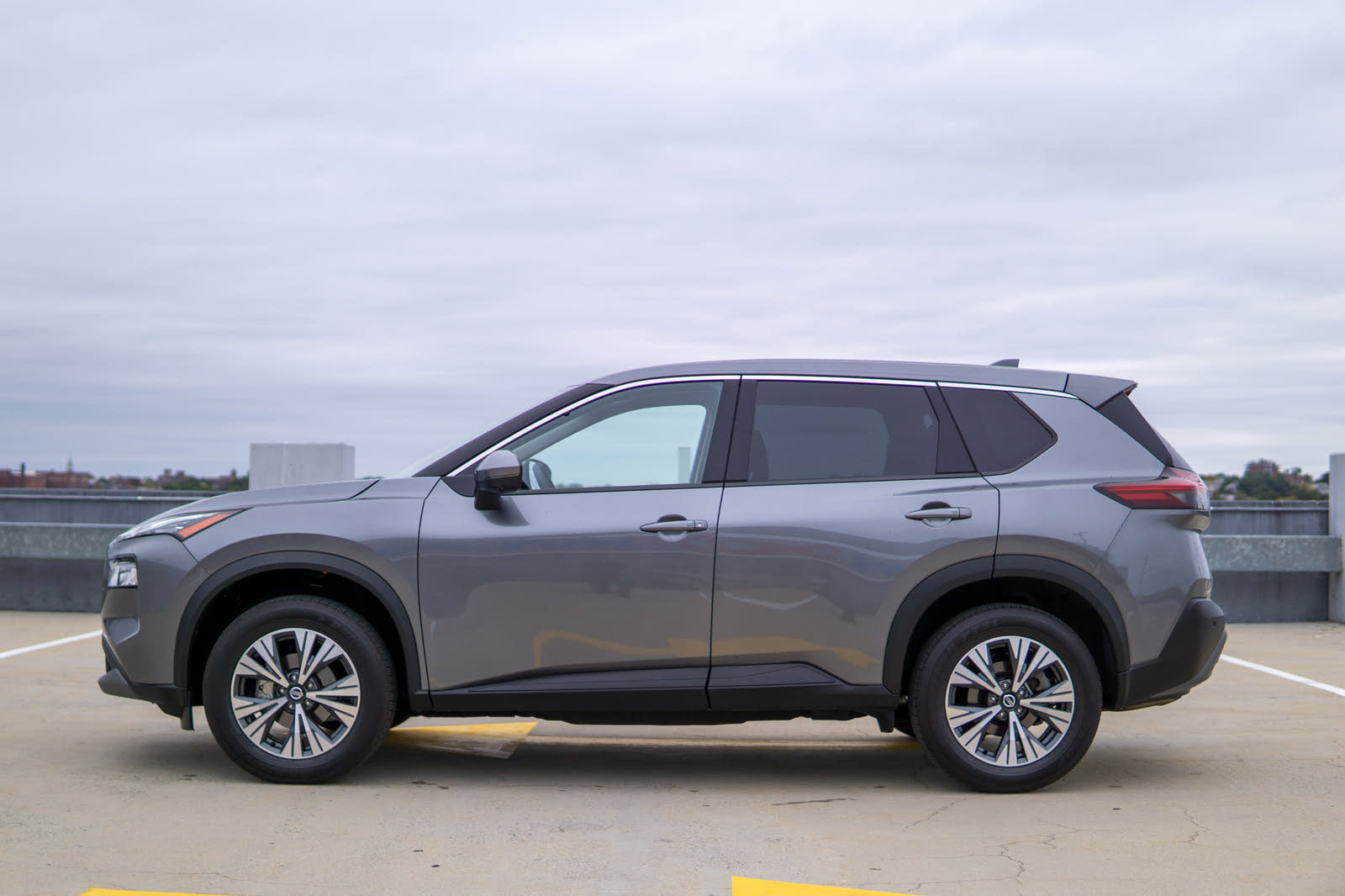
According to CarGurus experts, the overall rating for the 2021 Nissan Rogue is 9.0 out of 10, while the 2022 Hyundai Tucson scores 8.3 out of 10. Based on these ratings, the recommendation leans towards the 2021 Nissan Rogue. Its refined interior, advanced safety features, and improved driving dynamics make it the superior choice in this comparison. While the 2022 Hyundai Tucson offers a spacious interior and a range of powertrains, the 2021 Nissan Rogue delivers a more comprehensive package overall.
Choose the 2021 Nissan Rogue if:
- You value a meticulously designed and luxurious cabin with features like semi-aniline leather and ambient lighting in higher trims.
- You prefer a vehicle with a class-leading, advanced driver-assistance system (ADAS) as standard, including blind-spot warning and rear cross-traffic alert.
- You want a smooth and refined driving experience with significantly improved steering and handling over previous generations.
Choose the 2022 Hyundai Tucson if:
- You need more spacious and flexible interior and cargo space, ideal for families and longer road trips.
- You are looking for a variety of powertrain options, including a more powerful and fuel-efficient hybrid, with a forthcoming plug-in hybrid model.
- You appreciate comprehensive standard and available tech features, with options for larger digital displays and advanced connectivity.
CarGurus highlights

According to CarGurus experts, the overall rating for the 2021 Nissan Rogue is 9.0 out of 10, while the 2022 Hyundai Tucson scores 8.3 out of 10. Based on these ratings, the recommendation leans towards the 2021 Nissan Rogue. Its refined interior, advanced safety features, and improved driving dynamics make it the superior choice in this comparison. While the 2022 Hyundai Tucson offers a spacious interior and a range of powertrains, the 2021 Nissan Rogue delivers a more comprehensive package overall.
Choose the 2021 Nissan Rogue if:
Shop Now- You value a meticulously designed and luxurious cabin with features like semi-aniline leather and ambient lighting in higher trims.
- You prefer a vehicle with a class-leading, advanced driver-assistance system (ADAS) as standard, including blind-spot warning and rear cross-traffic alert.
- You want a smooth and refined driving experience with significantly improved steering and handling over previous generations.
Choose the 2022 Hyundai Tucson if:
Shop Now- You need more spacious and flexible interior and cargo space, ideal for families and longer road trips.
- You are looking for a variety of powertrain options, including a more powerful and fuel-efficient hybrid, with a forthcoming plug-in hybrid model.
- You appreciate comprehensive standard and available tech features, with options for larger digital displays and advanced connectivity.

By: CarGurus + AI
At CarGurus, our team of experienced automotive writers remain at the heart of our content operation, conducting hands-on car tests and writing insightful guides that are backed by years of industry experience. To complement this, we are harnessing AI to make our content offering more diverse and more helpful to shoppers than ever. To achieve this, our AI systems are based exclusively on CarGurus content, ratings and data, so that what we produce is both unique to CarGurus, and uniquely helpful to car shoppers.


